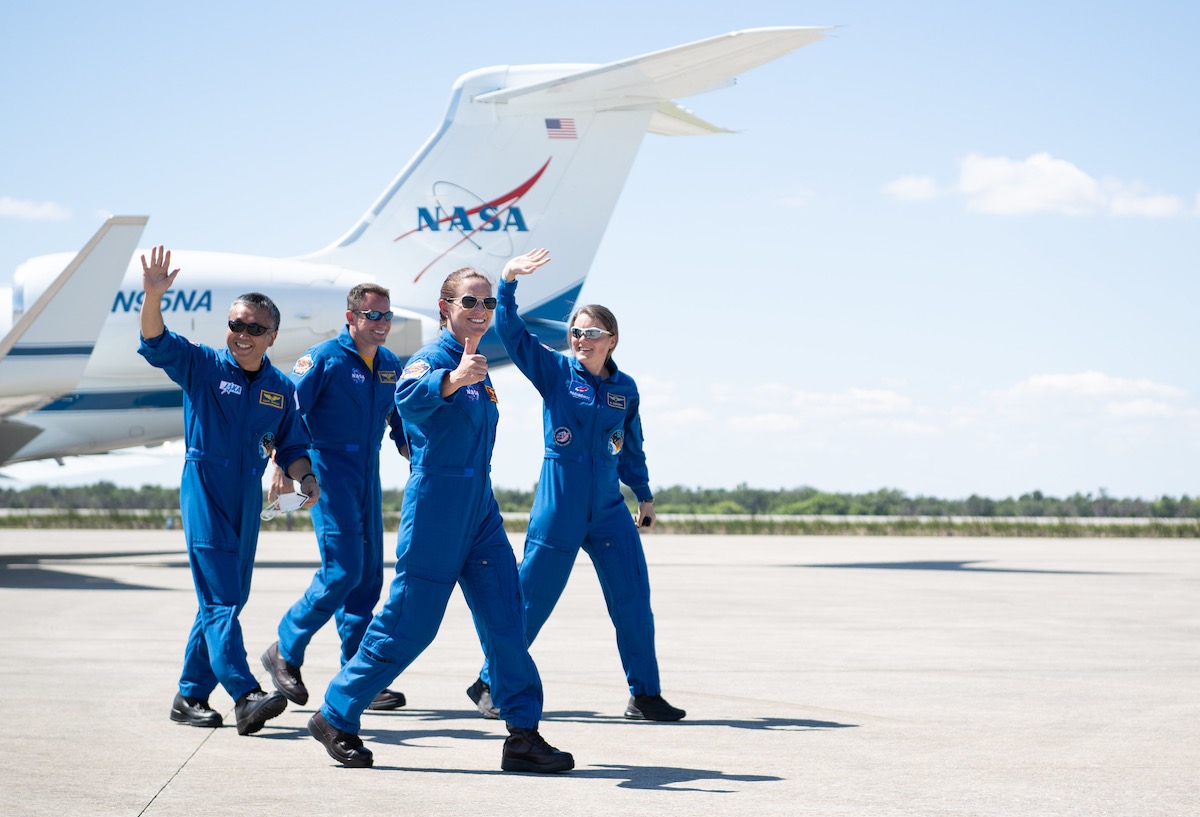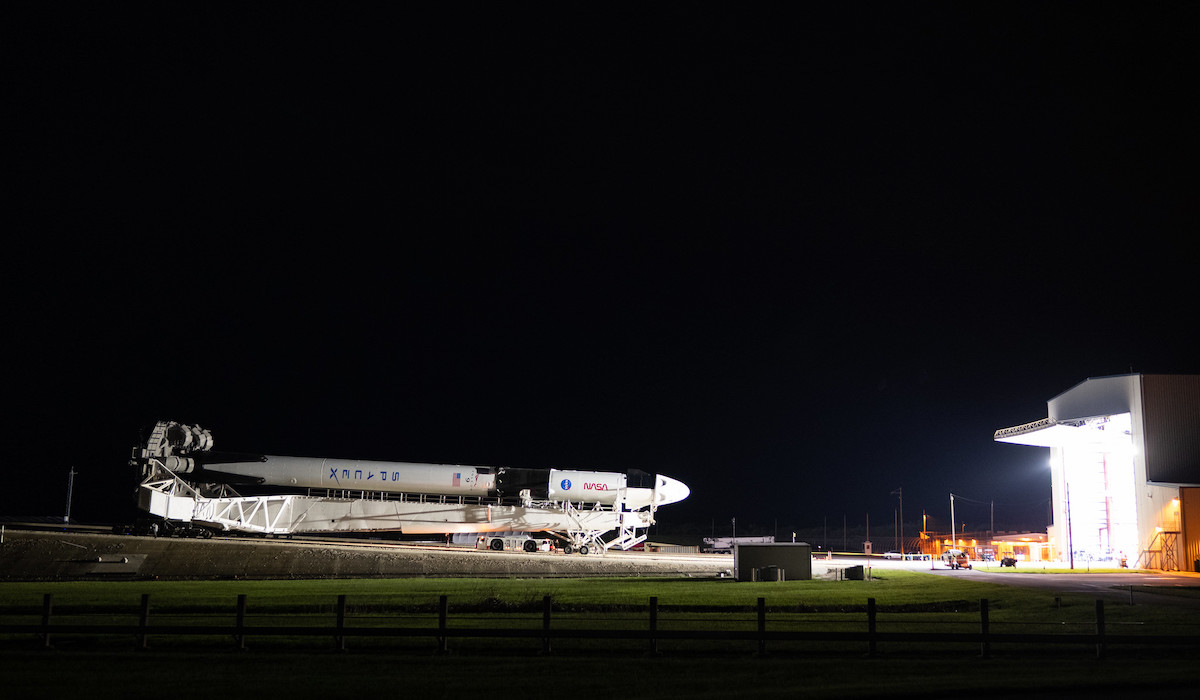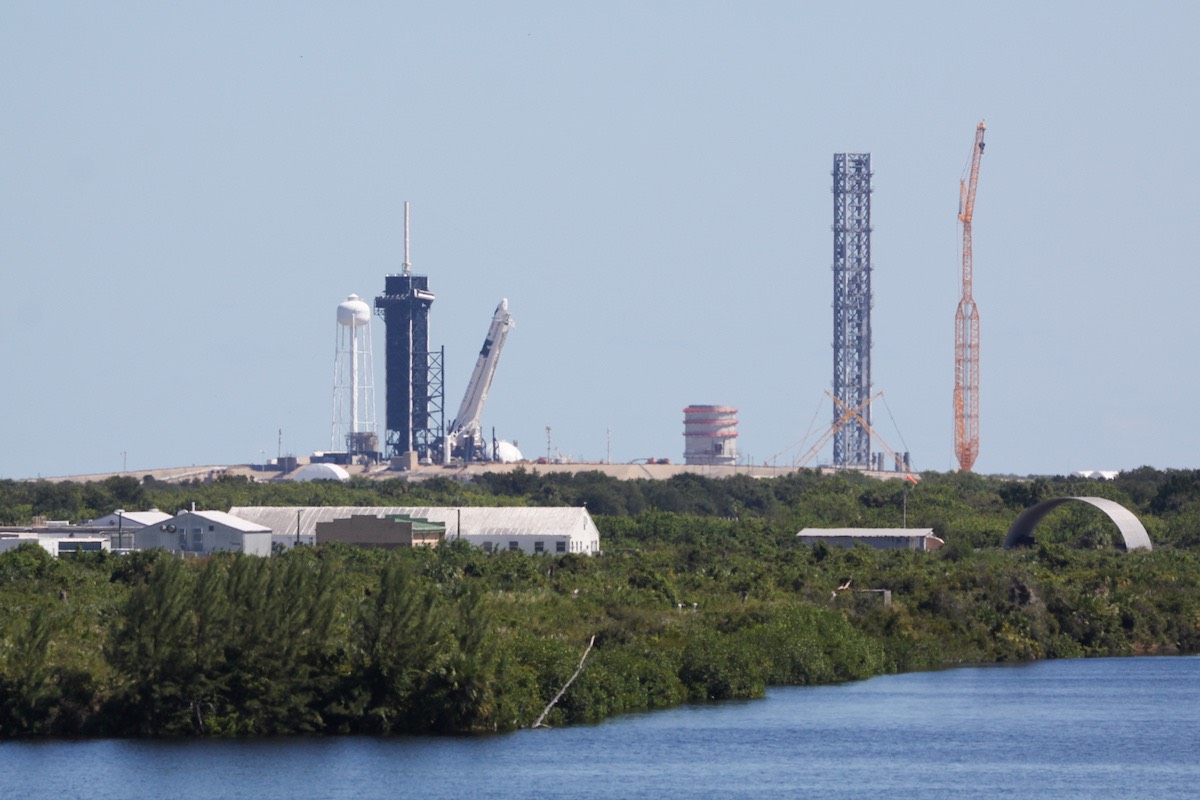Space News & Blog Articles
Preps resume for SpaceX crew launch after Hurricane Ian
 From left to right: Japanese astronaut Koichi Wakata, NASA astronaut Josh Cassada, NASA commander Nicole Mann, and Russian cosmonaut Anna Kikina arrive at Kennedy Space Center on Oct. 1 to prepare for launch to the International Space Station. Credit: NASA/Joel Kowsky
From left to right: Japanese astronaut Koichi Wakata, NASA astronaut Josh Cassada, NASA commander Nicole Mann, and Russian cosmonaut Anna Kikina arrive at Kennedy Space Center on Oct. 1 to prepare for launch to the International Space Station. Credit: NASA/Joel Kowsky
The next multinational crew scheduled to ride a SpaceX rocket and capsule to the International Space Station next week arrived at NASA’s Kennedy Space Center Saturday as ground teams rolled their Falcon 9 booster and Dragon Endurance spacecraft to the launch pad, resuming work suspended earlier in the week as Hurricane Ian moved across Florida.
Commander Nicole Mann, pilot Josh Cassada, and mission specialists Koichi Wakata and Anna Kikina rode a NASA Gulfstream business jet from their home base in Houston to Kennedy Space Center Saturday. After arriving shortly after 12 p.m. EDT (1600 GMT) at Kennedy’s Launch and Landing Facility — the runway once used for space shuttle landings — the crew members greeted NASA officials and answered a few questions from reporters.
“We are excited to finally be here in Florida, and we are ready for launch,” Mann said. “I would like to thank the NASA and the SpaceX team for all of their dedication and their flexibility in the wake of the hurricane. It’s incredible to see the team come together.
“When we flew in today, we had a chance to do a pad flyby, and although we come to the Cape quite often as astronauts, it’s a different feeling entirely when you come and you see the rocket that you’ll be flying on in a few days sitting on the launch pad. Together, as a crew, we’ve been training for almost a year, but our preparation has begun long before that.”
The Crew-5 mission is scheduled to launch at 12 p.m. EDT (1600 GMT) Wednesday, Oct. 5, from pad 39A aboard a Falcon 9 rocket. Assuming an on-time liftoff, SpaceX’s Dragon Endurance spacecraft, making its second flight to space, will dock with the International Space Station on Thursday. The flight will be NASA’s fifth operational crew launch on a SpaceX rocket and spacecraft, and SpaceX’s eighth astronaut mission overall, including two all-private crews and the first piloted Dragon test flight in 2020.
Mann and Cassada, both members of NASA’s 2013 astronaut class, are preparing for their first mission to space. They previously trained for flights on Boeing’s Starliner crew capsule, but NASA reassigned them to SpaceX missions after the Starliner program ran into delays.
Wakata, a Japanese astronaut, is the veteran of the Crew-5 team. This will be his fifth flight to space in an astronaut career spanning 30 years, following launches on NASA space shuttles and Russian Soyuz spacecraft.
Kikina was confirmed as the fourth crew member in July, when NASA and the Russian space agency, Roscosmos, finalized a “seat swap” agreement enabling Russian cosmonauts to launch and land on U.S. crew capsules and U.S. astronauts to fly to the space station on Russian Soyuz missions. Kikina, another first-time space flier, is the first Russian cosmonaut to launch on a U.S. spacecraft since 2002.
The seat sharing agreement is intended to ensure the space station is always staffed by at least one U.S. and one Russian crew member, allowing each country’s segment of the complex to remain fully operational even if there was a major problem or delay in U.S. or Russian crew launches.
 SpaceX rolls out a Falcon 9 rocket and the Dragon Endurance crew capsule at Launch Complex 39A early Oct. 1. Credit: NASA/Joel Kowsky
SpaceX rolls out a Falcon 9 rocket and the Dragon Endurance crew capsule at Launch Complex 39A early Oct. 1. Credit: NASA/Joel Kowsky
The four-person crew will live and work on the space station for about five months. They will replace the Crew-4 astronauts, who have been on the station since April and will depart for return to Earth about five days after Crew-5 arrives at the complex. Another SpaceX mission, Crew-6, is scheduled to launch no earlier than February with the next team of long-duration crew members to continue staffing the space station, which has been occupied continuously by astronauts and cosmonauts since November 2000.
The docking of SpaceX’s Dragon Endurance spacecraft at the space station will temporarily raise the size of the lab’s crew to 10 people. Russian cosmonauts Sergey Prokopyev and Dmitry Petelin, joined by NASA astronaut Frank Rubio, arrived at the station last month on a Soyuz spacecraft. When Crew-4 returns to Earth, the station will be back to its usual complement of seven crew members until the next series of crew rotations in early 2023.
The launch of the Crew-5 mission was delayed two days after Hurricane Ian forced teams at Kennedy to stop work earlier this week. Hurricane Ian weakened to a tropical storm as it passed directly over Kennedy Space Center Thursday, drenching Central Florida with flooding rains. The storm also prompted NASA to roll the Artemis 1 moon rocket from pad 39B at Kennedy back to the Vehicle Assembly Building for shelter.
NASA reported only minimal damage at Kennedy Space Center, allowing the workforce to return to the spaceport Friday.
Agency officials said they are now targeting a launch period that opens Nov. 12 for the next opportunity to launch the Artemis 1 test flight. Artemis 1, which will fly without astronauts, is the inaugural demonstration flight of the huge Space Launch System moon rocket, and the first flight of an Orion crew capsule around the moon. If it goes well, Artemis 1 will pave the way for future crew missions to the moon, beginning with Artemis 2 as soon as 2024.
“Fortunately, it was down to about 55-knot winds when it hit us, and we had some flooding and stuff, but overall we’re looking good,” said Bob Cabana, NASA’s associate administrator. “And it was really good that we got that big rocket back in the barn. Ian track right between pad 39A and B is it went across, and it was great knowing that SLS and Orion were safe getting ready for Artemis 1.”
The Falcon 9 rocket and Dragon Endurance spacecraft for the Crew-5 mission weathered the storm inside SpaceX’s hangar a quarter-mile south of pad 39A.
Ground teams rolled the rocket to the pad early Saturday and raised it vertical around midday. The next major step to prepare for Wednesday’s launch will be a dress rehearsal for the flight crew Sunday at pad 39A, when Mann, Cassada, Wakata, and Kikina will put on their SpaceX pressure suits and take their seats inside the Dragon Endurance capsule in a dry run before launch day.
Later Sunday afternoon, once the crew members are safely out of the spacecraft, SpaceX plans to load the Falcon 9 rocket with super-chilled kerosene and liquid oxygen propellants, culminating in a brief test-firing of the booster’s nine Merlin main engines on the pad. The static fire test is a customary milestone before every SpaceX crew launch.
The Falcon 9 booster slated to launch the Crew-5 mission is a brand new rocket. After launch, SpaceX plans to recover the booster on a drone ship positioned in the Atlantic Ocean a few hundred miles northeast of Cape Canaveral.
 SpaceX lifted a Falcon 9 rocket and the Dragon Endurance spacecraft vertical at Launch Complex 39A around 12 p.m. EDT on Oct. 1. Credit: Stephen Clark / Spaceflight Now
SpaceX lifted a Falcon 9 rocket and the Dragon Endurance spacecraft vertical at Launch Complex 39A around 12 p.m. EDT on Oct. 1. Credit: Stephen Clark / Spaceflight Now
The booster for Crew-5 was damaged during when part of the rocket struck a bridge during transport from SpaceX’s factory in California to a test site in Central Texas earlier this year. The repair work delayed the Crew-5 launch from early September.
SpaceX replaced the interstage on the booster, which connects the first stage with the second stage of the Falcon 9. The company also replaced avionics near the upper dome of the booster, according to Steve Stich, NASA’s commercial crew program manager.
Bill Gerstenmaier, SpaceX’s vice president of build and flight reliability, said the company also replaced a grid fin and a grid fin actuator on the booster. The rocket has four grid fins to help support steering and provide aerodynamic stability during its re-entry back into the atmosphere, before targeting a vertical landing on the drone ship.
Engineers performed inspections on the booster in Texas, then completed pressure, structural, and hotfire testing before shipping the rocket to Florida for launch processing.
“All that work passed, and we convinced ourselves that we’ve got a good vehicle to go fly,” Stich said.
This email address is being protected from spambots. You need JavaScript enabled to view it. the author.
Follow Stephen Clark on Twitter: @StephenClark1.
When you subscribe to the SpaceZE News Feed, we will send you an e-mail when there are new updates on the site so you wouldn't miss them.

